Chapter: Modern Medical Toxicology: Food Poisons: Food Poisoning
Prickly Poppy - Food Poisoning
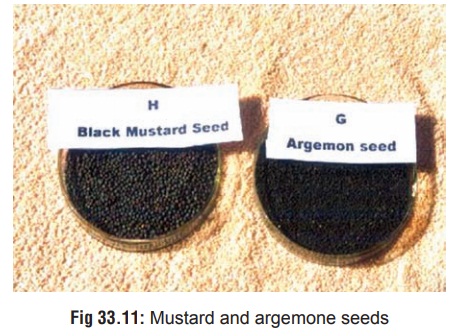
Prickly Poppy
Other Common Names
Yellow
poppy, Mexican poppy.
Botanical Name
Argemone mexicana
Physical Appearance
This
is a robust, prickly, annual or perennial herb belonging to family Papaveraceae,
which grows up to 4 feet in height, bearing thistle-like leaves and yellowish
flowers ( Fig 33.9) (Fig 33.10). The spreading branches are
prickly and contain a yellow sap. The leaves are pinnately cut, while the
flowers are solitary, showy, and yellowish. The fruit is a prickly capsule, and
bears many small seeds which are tiny and brownish black. They resemble the
dark variety of mustard (Brassica nigra)
(Fig 33.11).*
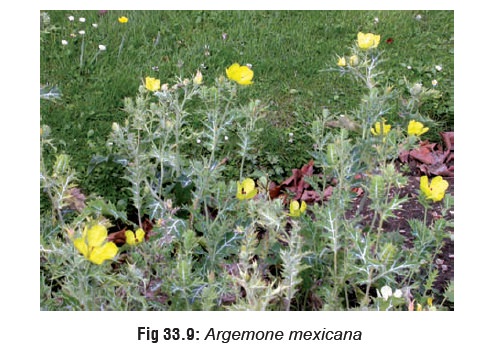
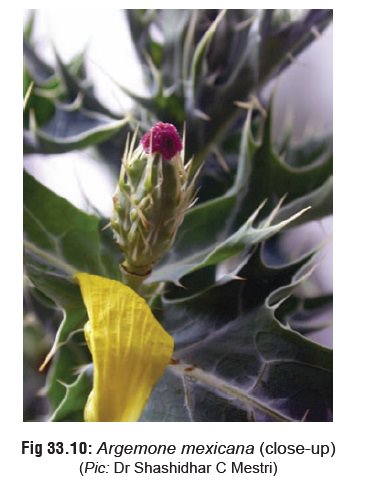
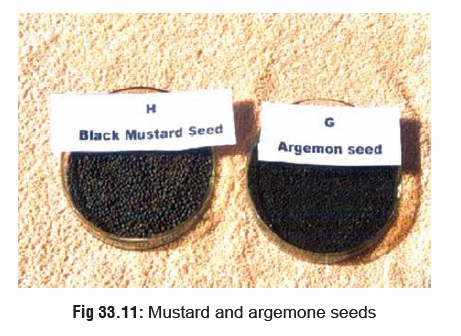
Uses
There
is no legitimate use for argemone seeds or the oil extracted from them. In
India, mustard oil and other vegetable oils are often adulterated deliberately
with argemone oil. Sometimes the dark variety of mustard seeds is adulterated
with argemone seeds.
Toxic Part
Seed
and expressed oil are quite toxic. Leaves are also toxic (to a lesser degree).
Toxic Principles
·
Sanguinarine
·
Dihydrosanguinarine.
They
are both physiologically active benzophenanthridine alkaloids. In addition,
other alkaloids of lesser importance are present, such as protopine, berberine,
chelerythrine, isoquino-line, and coptisine.
Berberine and protopine are found throughout the entire plant, while sanguinarine and dihydrosanguinarine are found in the seeds.
Mode of Action
·
Liver, heart, kidneys, and lungs are
the target organs of argemone alkaloids, and it is postulated that membrane
destruction is the probable mode of acion. The exact mecha-nism is not well
understood.
·
The chief effects of argemone are on
the blood vessels which become abnormally permeable, resulting in the leakage
of protein-rich plasma components into the extravascular compartment leading to
hypovolaemia and reduced plasma osmotic pressure. Decrease in renal blood flow
sets into motion a compensatory mechanism through the activation of
renin-angiotensin-aldosterone system, and retention of sodium and water.
Conservation of fluid and salt compensates for the expanded vascular capacity
and increased permeability in mild cases.
·
However in severe cases, these
mechanisms become inadequate because fluid and salt conserved by kidneys are
poorly held in the vascular compartment due to low plasma osmotic pressure. As
a result, a state of relative hypovolaemia exists, which provides a constant
stimulus for renal conservation of salt and water, which in turn causes marked
anasarca.
·
Exudation of protein-rich fluid from
pulmonary capillaries results in pulmonary oedema which gets compounded by
right-sided cardiac failure. As a result, congestive hepato- megaly develops.
Similar mechanisms underlie effusions in the pleural, pericardial, and
peritoneal cavities.
·
Mechanisms of toxicity of argemone
alkaloids are summarised in Table 33.8.
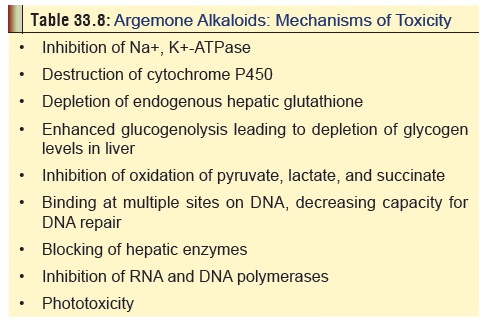
Clinical Features
Chronic
consumption of food prepared with adulterated mustard or vegetable oils results
in a condition called epidemic dropsy.
Onset is usually insidious with slowly progressing, pitting pedal oedema, and
limb pain. Diarrhoea, abdominal pain, and fever are often present in the early
stages. Other features comprise the following:
·
Skin—Superficial
patchy erythema, telangiectasias, sarcoids (purplish blotches over lower
limbs), pigmenta- tion, and hair loss.
·
Eye—Glaucoma,
superficial retinal haemorrhages, venous dilatation, central serous
retinopathy, and disc oedema.
·
CVS—Palpitations,
tachycardia, hypotension, congestive cardiac failure.
·
RS—Dyspnoea,
pulmonary oedema.
·
Hepatorenal—Hepatomegaly,
renal dysfunction.
·
Haematological—Normocytic,
hypochromic anaemia, with raised ESR.
Differential Diagnosis
·
Hypoproteinaemic states
·
Nephrotic syndrome
·
Beri Beri
·
Filariasis
·
Hypothyroidism.
Diagnosis
·
Diagnosis of epidemic dropsy:
o Anaemia.
o Raised plasma pyruvate level.
o Chest x-ray: cardiomegaly, pulmonary oedema.
o ECG: ST, T wave changes, atrial/ventricular extrasys-toles.
o Hypoalbuminaemia, raised alpha-2
globulin, reversal of albumin-globulin ratio.
o Blood urea and creatinine may be
raised.
·
Identification of adulterated mustard:
o Adulteration of light yellow mustard
seeds with argemone seeds can be easily made out by visual inspection.
o Adulteration of dark mustard seeds
can be detected by placing the seeds in normal saline. Mustard seeds will sink,
while argemone seeds will float
·
Identification of adulterated mustard oil:
·
Nitric acid test: 5 ml oil is shaken with an
equalvolume of HNO3. On standing, the acid layer turns yellow,
orange, or crimson, depending on the amount of argemone oil. This test has a
high incidence of false positives, and therefore a positive result must always
be confirmed by other tests.
·
Ferric chloride test: 2 ml oil is mixed with 2
mlconcentrate HCL, and heated in a water bath at 35° C for 2 minutes. 8 ml
ethanol is then added, and heating continued for 1 more minute. Finally, 2 ml
ferric chlo-ride is added, and the mixture heated for a further 10 minutes.
Positive result is indicated by an orange-red precipitate.![]()
·
Paper chromatography: It is the most sensitive method,and
can detect down to 0.0001% adulteration with argemone oil.
·
Thin Layer Chromatography: Researchers at the National
Institute of Nutrition, Hyderabad, have devel-oped a highly sensitive
quantitative assay of sangui-narine by thin layer chromatography.
Treatment
·
Withdrawal of contaminated oil from
the diet.
·
Bed rest, leg elevation,
protein-rich diet.
·
Supplements of calcium, antioxidants
(vitamins C & E), and B vitamins.
·
Corticosteroids.
·
Diuretics.
·
Management of cardiac failure: bed
rest, salt restriction, digitalis, and diuretics.
·
Recalcitrant glaucoma may require
surgical intervention.
·
Most patients recover with treatment
in about 3 months. Mortality is around 5%. Post-recovery, pedal oedema may take
up to 5–6 months to resolve completely.
Forensic Issues
·
The first case of epidemic dropsy was reported in 1877 from
Calcutta (Kolkata). Since then, numerous cases usually in the form of periodic
epidemics, have occurred not only in India, but also in some other countries
such as South Africa, Myanmar, Mauritius, Madagascar, and the Fiji islands. It
is perhaps significant that in most of these countries, a sizeable chunk of the
population comprises people of Indian origin.
·
Epidemic dropsy is in many ways a uniquely Indian syndrome,
and more so a North Indian syndrome. The outbreaks have mostly been confined to
West Bengal, Bihar, Madhya Pradesh, Orissa, Uttar Pradesh, Gujarat, Delhi, and
Maharashtra. The most recent epidemic occurred in 1998 in Delhi, claiming 65
lives out of a total number of 2552 cases reported from all across the state.
·
Almost all the outbreaks have been due to consumption of
mustard oil or other vegetable oils contaminated with argemone oil (except the
South African epidemic which occurred due to adulteration of wheat flour with
argemone seeds). South Indian states have been largely spared because mustard
oil is not very popular here.
Related Topics